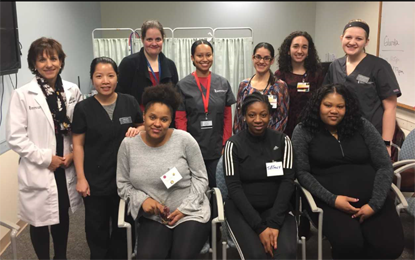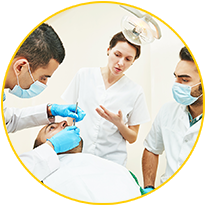An expanding interprofessional collaboration between the University of Maryland School of Medicine (UMSOM) and the University of Maryland School of Dentistry (UMSOD) is facilitating oral health care for prenatal patients at the Western Penn Women’s Health Center at the University of Maryland Baltimore (UMB).
Under a pilot project, titled “A Prenatal Oral Health Program in a University-Women’s Health Clinic,” prenatal/infant oral health educational training presentations are given to prenatal providers in the UMSOM Department of OB/GYN and Reproductive Sciences, and dental hygiene students provide oral health education and screenings to pregnant patients at the clinic. Patients who do not have a dentist but express interest in seeking care are referred to UMSOD and receive follow-up calls to schedule appointments with dental hygiene students.
The project is funded through a grant from the American Dental Hygiene Association’s (ADHA) Institute for Oral Health and is given collaborative support from the Maryland Department of Health (MDH)’s Perinatal Oral Health Quality Improvement Project. During the first year, the project already has seen an increase in the rate of patient referrals, and patients are being referred earlier in their pregnancy.
“We are now averaging 4-5 referrals a week from prenatal providers and the patients are around 8 to 9 weeks pregnant versus 32 weeks, which is very exciting, because we have more time to address their dental concerns,” says Lisa Bress, RDH, MS, clinical assistant professor at the Division of Dental Hygiene at UMSOD and project leader.

The Prenatal care team provides oral health education to pregnant patients.
This program takes advantage of Maryland’s Medicaid benefits, which expands to include dental coverage during the course of a woman’s pregnancy. Since a majority of the patients visiting the UMWHC are low-income and underserved, the program provides a rare opportunity to provide both treatment and education for prenatal patients, many of whom are in their early 20s and suffer from severe dental decay, says Bress.
“During pregnancy there are physiological changes that adversely affect oral health including increased inflammation of the gingiva and severity of periodontal disease,” she says. “In addition, caries causing bacteria can be transferred from the parent to the child after delivery. The healthier the mom’s mouth is the healthier her children’s mouths will be.”
The project also aims to dispel the perception that providing dental care for prenatal patients is unsafe.
“A lot dental providers won’t see pregnant patients, but it’s safe throughout the pregnancy,” says Bress, adding, “We stress the following: ‘It’s safe, it’s covered, and it’s important.’”
Typically, low-income prenatal patients go to the emergency department when they experience dental pain. Through this project, Registered Nurses (RNs) at the UMWHC have been trained to ask a series of questions to determine whether prenatal patients may need dental treatment, which can prevent a trip to the emergency department and secure a dental home for many patients who haven’t seen one in many years.
“It used to be the RN’s only asked, ‘Do you have a dentist?’ Now they’ve added three additional questions. ‘Do you have dental pain? Do your gums bleed? And when’s the last time you had a cleaning?’ This helps us determine if patients go to the dentist regularly or only when they are in pain,” Bress says.
To help facilitate the link between referrals from the women’s health center and UMSOD, the project collaborates with the Masters in Public Health Program through the UMSOM Department of Epidemiology and Public Health. MPH students working on their capstone project (a requirement for the MPH degree) help manage patients’ barriers to seeking dental care. This includes helping navigate the complex insurance processes, appointment scheduling, and working with UMSOD business managers to develop a protocol that works with the dental school’s patent care process.
“By creating a dental referral protocol for the Women’s Health Center, the dental utilization rates of pregnant patients increased and dental health was fully incorporated into prenatal care at the Women’s Health Center,” said Marina Schmidt, MPH student at UMSOM.
“This project is unique because it increases access to care and enhances education for medical students, OB-GYN residents, dental hygiene and dental students, and Masters of Public Health students,” says Bress, “In addition the dental hygiene program collaborates with undergraduate dental faculty as well as faculty in the oral surgery clinic.”
In 2019, the project received additional support from the National Maternal and Oral Health Resource Center (OHRC) at Georgetown University. “A prerequisite was a clinic had to already be incorporating oral health into primary care, so we were well-positioned to be selected,” says Bress.
In fact, Maryland was one of only five states selected to participate in OHRC’s Partnership for Integrating Oral Health Care into Primary Care project, and the UMWHC was the only clinic in Maryland selected. This funding will provide training for nurse midwives on how to provide oral health screenings, education, and fluoride varnish applications and referrals to UMSOD.



